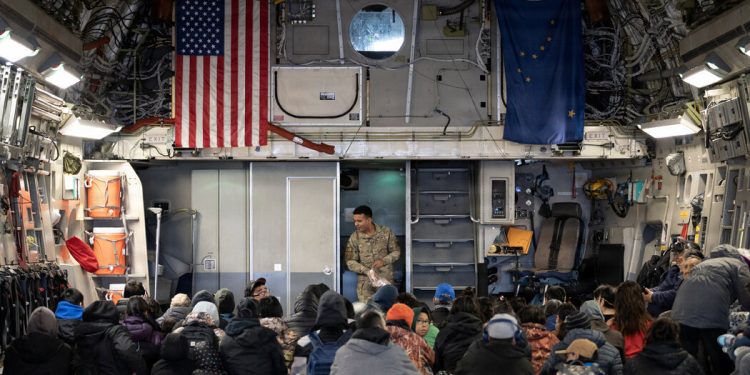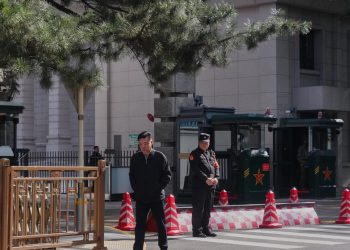At a shelter in downtown Anchorage on Saturday, 74-year-old Arthur Lake was still dealing with the shock of his new surroundings. Cars buzzed along one of the city’s main thoroughfares with loud mufflers and blasting stereos.
Mr. Lake and his family recently evacuated Kwigillingok, a small Alaska Native village on the Bering Sea, nearly 500 miles away. There, homes and businesses on the soft, grassy tundra were connected by boardwalks, and men hunted bearded seals and other marine mammals to prepare for winter.
“This is where we belong,” Mr. Lake said. He’s been to Anchorage several times. But, he said, “it’s not my home.”
For Mr. Lake and about 2,000 others who saw their isolated western Alaska communities devastated by the remnants of Typhoon Halong last weekend, life as they know it is gone, and it is unclear when — or even if — they will be able to return.
The storm, which killed at least one person and left two others missing, led to what Gov. Mike Dunleavy called the largest humanitarian evacuation operation in state history. Emergency officials have warned that in many cases entire villages will have to be rebuilt.
Mr Dunleavy said it could be at least 18 months before people could return home. But the level of destruction and the cost of reconstruction could complicate this timetable.
In the short term, evacuees like Mr. Lake suffer the loss of their homes, their way of life and a culture they consider sacred.
Dan Winkelman, general manager of the Yukon-Kuskokwim Heath Corporation, which works with local tribes to oversee health care for about 30,000 people in the hardest-hit region, said Anchorage evacuees are experiencing multiple traumas.
“It’s a series of waves. It’s not just the tidal wave of the storm,” he said.
There was a storm that happened in the dark of the night, he said. Then there was the experience of evacuation. Today they are in mass shelters in an unknown city, many without money or identification. Some know people who can help them in Anchorage, he said, but others don’t.
“They don’t have any of their belongings,” he said. “I visited five families in our shelter the first night. Half of them only had T-shirts and pants.” He said some older women didn’t even have shoes. “We had to dress them,” he said.
Downtown Saturday, dozens of volunteers were collecting donated supplies, both for evacuees and communities across Western Alaska. “We need adult diapers, we need formula, we need shoes, we need winter clothes,” said Adam Hays, one of the organizers.
Beyond their basic needs, many evacuees also face an adjustment to Anchorage, which, although many of them have visited it before, is culturally far removed from their region. In many of the hard-hit communities, people speak Yup’ik, an Indigenous language, fluently, and hunting and fishing seasons set the rhythm of life.
Ralph Fox, 64, and his wife Shirley, 60, who were staying at another shelter in Anchorage, were lamenting the loss of their winter food supplies. Ms. Fox wiped away tears as she talked about the animals and berries they hunted, fished, gathered, processed and stored in a freezer in their home that was lost in the flood.
Mr. Lake, who has lived in Kwigillingok, or Kwig, as locals call it, for decades and served as a tribal administrator before retiring, said he was worried about the children who were evacuated, who are now in shelters but are accustomed to a life mostly outside.
“I feel for them because the concrete jungle is not going to work for these kids,” he said, adding that “it’s going to take a while, if they want to adapt to it.”
Taylar Sausen, communications director for the American Red Cross of Alaska, said the organization was initially ordered to prepare to house 1,400 people in Anchorage. Some found shelter in other villages and some came to Anchorage to stay with family and friends. As of Sunday morning, there were 240 people in shelters, and airlifts continued to arrive.
Mayor Suzanne LaFrance visited the shelters over the past few days and spoke with evacuees as they arrived. “Their stories are absolutely heartbreaking,” she said, noting that they lost not only their homes, but also the essential tools needed to make a living off the land, including ATVs, boats and snowmobiles.
“We will do everything we can here in Anchorage to welcome our western Alaska neighbors and help them through these difficult times,” she said.
The mayor said the city was working to find more housing, including hotel rooms and apartments, that could be made available to people over a longer period of time. A complication, however, is that the city was already struggling with a housing crisis.
In April, Ms. LaFrance announced a plan to add 10,000 housing units in 10 years. Last week, she declared a state of emergency in the city to free up more resources to help evacuees.
Local and state officials continue to assess the damage and what lies ahead. Mr. Dunleavy, the governor, who asked President Trump for federal aid, called the destruction catastrophic.
Sen. Lisa Murkowski, Republican of Alaska, spoke Saturday at the Alaska Federation of Natives convention in Anchorage and told the audience that she had visited Kipnuk, one of the hardest-hit areas, where officials estimate 90 percent of structures were gone. She said she expects it will take years for communities to recover.
Aerial photographs of the areas do not fully capture the level of destruction, Mr. Winkelman said. He added that in Kwigillingok, 53 houses were blown away and it appeared the village had been bombed.
Mr. and Mrs. Fox remember the terror their family felt as they tried to reach safety in Kipnuk the night of the storm. They were at home with their extended family, including three daughters and seven grandchildren. Mr. Fox woke up between 1 a.m. and 2 a.m., he said, and other members of his family were already awake. A granddaughter opened a window and saw a lot of water outside, and Mr Fox said he became concerned.
After water seeped into the house, they called a neighbor who owned a house on stilts nearby. Looking out at the storm, Mr. Fox estimated the water would be up to his chest. He put on his waders and asked his family to get extra clothes. He and Ms. Fox agreed that they would all link arms and form a human chain. He picked up an infant granddaughter in one arm and held his 18-year-old daughter in the other, he said. The family walked out onto their porch and then down into the cold, dark water.
Ms Fox said the force of the wind was overwhelming. “It was so strong I couldn’t catch my breath,” she said.
When they were halfway to the neighbor’s house, Mr Fox said his daughter tripped. She was face down in the water and appeared to have passed out, he said. He tried to turn her with his free hand, then she began to move. He picked her up, hugged her, and they managed to reach the other house.
There they saw a house crowded with other people taking shelter from the storm. The water continued to rise, flowing under the door, forming puddles around their feet. But eventually, Mr. Fox said, the tide changed and the water fell, and they were able to walk to a school for shelter.
Many generations of their families have lived in Kipnuk, Mr. Fox said. When asked if he thought they would return, he shook his head.
“It’s not a house anymore,” he said. “It’s, it’s, it’s not credible.”









